Gretta Sarfaty Marchant
| Gretta Sarfaty Marchant | |
|---|---|
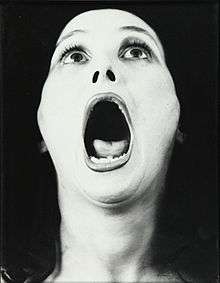 Gretta Sarfaty Marchant, PerFormative, Sartorial Contemporary Art, 2011 | |
| Born |
Alegre Sarfaty 1947 Athens |
| Nationality | British and Brazilian |
Gretta Sarfaty Marchant (also known as Alegre Sarfaty, Gretta Sarfaty Grzywacz, Greta Sarfaty Marchant) is an artist and curator who lives and works in London, São Paulo and New York. Marchant has earned international acclaim as a feminist performance artist. Alongside her art she was the founder of the project-led space, Sartorial Contemporary Art (2005–2010) and since 2010 has been running a family trust the Alegre Sarfaty Collection.[1]
Early life
Marchant was born in Athens in 1947[2] and was named Alegre Sarfaty, from parents of Italian, Greek and Turkish origin. In 1954, her family moved to São Paulo, Brazil.[3] At the age of 17 she married José Grzywacz; she has three children from this marriage: Victoria Sarfaty Grzywacz, Pedro Grzywacz and Rafaela Grzywacz Goodman. She started creating her first artworks when she was 25. She continued her art studies in Brazil, and later lived and worked in Paris, Milan and New York.
Artistic career
Throughout her career Marchant exhibited mainly in São Paulo, New York and London. In the 70s she participated in numerous solo shows in Brazil displaying her early paintings. Her world travels and mixed background has had an important influence on her more contemporary visual work – particularly her photography and collages which deal in themes of identity and culture, although her art is not restricted just to the canvas. Marchant's work embraces a wide range of media including installation, photography, video, paintings and performance.
Brazil and Europe
At the beginning of the 70s she started creating the series of paintings, Metamorphosis and her work was noted by the Brazilian gallerist, Franco Terranova. In 1976 he showed her works in the Galeria de Arte Global, in São Paulo.[4] In 1979 she had several shows in Germany (Karlsruhe) and in Italy (Galleria Diagramma, Milan; Palazzo dei Diamanti, Ferrara) and also in Paris, Centre Georges Pompidou, where she performed the Evocative Recollections. In 1983 she created a series of paintings with a book, dedicated to the Brazilian culture, Self-Portrait of Brazil.
Auto-Photos
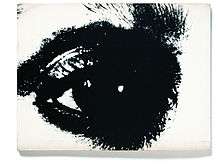
This series of photos from 1976 is one of the first Marchant's artworks dedicated to female identity and its various demonstrations: her face appears in sequences of beauty and ugliness, grace and madness.[5] A frivolous play with recurrent images of herself is in fact an ironic dialogue with the constructed cultural image of a woman. Marchant expresses in this series the notion of gender performativity, a term created by Judith Butler in 1988.
Roberto Pontual wrote about this work:
The work of Gretta has been originally more related to the language of photography, especially during her recent stay in Europe. Her main focus has always been the female body, including her own body "as a symbol of women's condition in our society.[6]
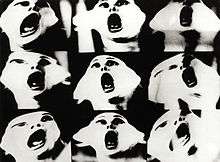
Transformations
Here the topic of deconstructing the female image gains even more strength.[7] Marchant's face is being manipulated and distorted:
Rather than the manifestation of personal destructive tendencies, these images should be viewed as the externalisation of a revolt directed against the male cultural stereotype, mortifying as it does the feminine form into the authoritarian and distorting dimension of an abstract and aesthetic beauty, to which the artist opposes the angry vision of a reverse side, through a body that is deformed, disfigured and fragmented.[8]
A Women's Diary
Another work from 1976 where Marchant uses photography to create a diary of her own body, captured in almost abstract poses. The way that the body appears on the photos calls into question its materiality.
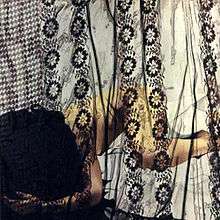
Evocative Recollections
In 1979 she performed Evocative Recollections (performance with catalogue) in Centre Georges Pompidou, Paris, as well as in Pallazzo di Diamanti di Ferrara, Italy.[9] This performance was then showed in different locations in Belgium (Internationaal Cultureel Centrum, Antewerp[2]), Brazil and Italy. Under the same title, Evocative Recollections, Marchant continued the topic of female body and women's liberation in the series of photos (1980–1981). In an essay published for Marchant's solo exhibition at the Centro Culturale La Filanda (Verano Italy) Gillo Dorfles wrote about this series:
Sure: such pictures will not be the same with another artist, with another option, however, even considered under a point of view of photographic document, Gretta's corporeal options reach an unusual efficacy. We are in front of a little common combination, between the creative activity of an artist who knows how to enjoy the expressive dynamic and plastic possibilities of her body and the realisation of a photographic documentation which remains autonomous as well as in its technical as in its aesthetic values.[10]
New York
In 1983 Marchant moved to New York[3] and after a traumatic event, the fire in the Hotel Chelsea,[11] she began a collaboration with American video and performance artists (InterComm group). She also started to discover Kabbalah esoteric thought: she became friends with Simon Jacobson and Kenny Vance and she decided to picture the Kabbalah community in her paintings (Kabbalah, 1984–1985). She also created a performance, Goya Time (1985) and a video, My Single Life in New York (1987).
By the time she was represented by the New York-based gallery, Foster Goldstrom Fine Arts, she was involved in the artistic and cultural life of the city and she got to know Arthur Penn, with whom she collaborated in 1993 on his film The Portrait.
Body Works
In the late 80s and early 90s Marchant created a photographic series of Body Works, where naked bodies
constitute a denunciation of the hedonistic and alienating practices to which the female form is submitted, a denunciation of the repression and mystification to which women's education exposes them from every direction. And they are an affirmation of the real sensuality of women, which respectability nonetheless still attempts to hide or to repress (the curtain or the mosquito net). And so, like gallery owner Romana Loda, we can quote Hugo Von Hofmannsthal when he said: "The profound should be hidden. Where? On the surface".[12]
Gretta & Becheroni: Change and Appropriation of an Autonomous Identity
Video[n 1] made in 1980 in collaboration with Elvio Becheroni. Marchant perform in a cube made of paper ribbons, making herself a passage through the space. It is a metaphoric way to the new identity.
Goya Time
Inter-disciplinary multimedia event with 100 artists, curated by Marchant, Sandro Dernini and Butch Morris. Marchant wrote a script and directed this art opera inspired by Francisco de Goya's artworks. The performance took place in 1985, in "Quando", church and a car park at the Lower East Side, New York.[n 2]
Virtual Body Works 1988/2013
During the Spring of 1987 Marchant was invited to participate in an interactive telecommunications event, Who Killed Heinrich Hertz?,[n 3] created by InterComm (Timothy Binkley, George M. Chaikin, Ira Schneider and Willoughby Sharp). She became involved in collaborative work with each of the above video artist. In 1988 Ira Schneider created a video dedicated to Marchant.[n 4]
Myth
Video[n 5] produced by Denny Daniel, in 2003. It is a compilation of snapshots of Marchant, manipulated with a kaleidoscopic effect and juxtaposed with scenes from Marchant's everyday life. The structure of the movie remains the style of music videos from the late 80s.
London
In 1995 she moved to London and married Richard Marchant, "the leading Oriental ceramics dealer".[13] She continued creating photography related to questions of femininity and identity.
Reflections of a Woman
Woman as a central artistic subject appears not only in her auto-portraits but also in the series of paintings dedicated to an issue of female identity and body, Reflections of a Woman (1997). It was exhibited in the Wolseley Fine Arts, London, in 1997.[13]
In this series of paintings Gretta is talking not only about herself, but also about other women. She has found a way to represent women's nature. It is not her body any more, but every woman's body. They can still be self-portraits, but they also are portraits of the women of today, full of confidence about their own identity and conscious of their power.[14]
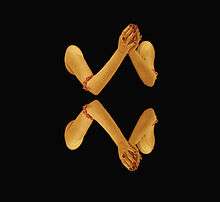
Recent activity
In 2005 she opened her own gallery, Sartorial Contemporary Art. In October 2008 this moved to a larger space in Kings Cross. Marchant has curated several of its shows including Notting Heaven (2008), Mothers (2008), Remember My Name (2008), Burning Candy (2008), Obsession (2006) and Water (2006). Along with Jasper Joffe and Harry Pye she has been a co-editor of The Rebel magazine.
In 2010 she has exhibited in the show Bad Girls, together with Marina Abramović, Annette Messager, Orlan and Gina Pane. The concept of the exhibition was to compare four generation of female artists since the 70s. In 2011 her works were shown in an exhibition at the Pinacoteca do Estado de São Paulo Arte como registro, registro como arte,[15] documenting the history of art performance in Brazil. The show highlights Marchant as one of the few Brazilian artists to ever exhibited at the Centre Georges Pompidou. One year later she participated in Foto/Gráfica – a New History of the Latin-American Photobook (where she exhibited her Autho-Photos), at Le Bal,[16] Paris and Libriste – Dalla collezione di libri d'artista di Marco Carminati: Gretta Sarfaty & Elvio Becheroni . Modificazione e appropriamento di una identita autonoma at the Instituzione Biblioteca Classense in Ravenna, Italy.
Exhibitions
Selected solo exhibitions
- 1979 - Evocative Recollections (performance with catalogue), Centre Georges Pompidou, Paris, France[17]
- 1983 - Auto-Retrato do Brasil – Museu Nacional de Belas Artes, Rio de Janeiro, Brazil[3]
- 1983 - Auto-Retrato do Brasil (with book) – Museu de Arte de São Paulo, Brazil[3]
- 1988 - Europa, França e Bahia – Museu da Imagem e do Som and Museu Paco das Artes. Marchant's retrospective of 15 years of works (with catalogue) comprising paintings, videos, performances, lectures and works in collaboration with Timothy Binkley, George Chaikin, Ira Schneider, Willoughby Sharp and others. Sponsored by the Brazilian Government. Curated by Marchant and Willoughby Sharp, São Paulo[18]
- 1993 - Body Works (performance and photos with catalogue) – exhibited in Foster Goldstrom Gallery, New York and also in Jansen-Perez Gallery, Los Angeles and San Antonio, Texas
- 1997 - Reflections of a Woman(with catalogue), Wolseley Fine Arts, London
- 2002 - Myth of Womanhood & Youth versus Gravity (with catalogue) Sartorial Contemporary Art. Curated by Julia Weiner, Head of Education at the Courtauld Institute of Art, London
- 2003 - Life Works (solo exhibition) – 473 Broadway Gallery, New York, US
- 2006 - X-RAY at the Perseverance, London
- 2008 - Gretta's Progress (photos, performance with catalogue) at Leeds College of Art & Design. Curated by Harry Pye and Olly Beck, Leeds, UK
- 2009 - Gretta's Permutations (installation and video). The show features "Gretta's Progress" by Gordon Beswick,[n 6] a half-hour documentary about Gretta's life since the 80s, London
- 2010 - Through a Glass Darkly (photos, performance).[n 7] Film by Gordon Beswick, Sartorial Contemporary Art, London
- 2011 - Arte Como Registro, Registro Como Arte(performance with film)[19] – Pinacoteca do Estado de São Paulo, Brazil
- 2013 - Familia Memorabilis, Wedding Pictures and Sartorial Giveaway of a Lifetime! (Paintings, photos, video and installation). Marchant’s project led-space, Kings Cross, London
Selected group exhibitions
- 1980 - Espaces Libres, Musée d'Art Moderne de la Ville de Paris, France
- 1981 - International Triennal of Drawings, Warsaw, Poland
- 1985 - Purgatorio Show ’85 New York, at C.U.A.N.D.O., organised by Willoughby Sharp Studio, Plexus & Sandro Dernini, New York
- 1987 - Summer Solstice '87, Art Performance 'The Marriage,' Marchant and Willoughby Sharp in WNYC-TV special by Charlie Morrow with: John Cage, Melissa Fenley, Philip Glass, Butch Morris, NY
- 1987 - Art in Mind, La Viande Gallery, London
- 2005 - The Oh House & The Night on Earth, The Oxford House, Curated by Harry Pye, London
- 2005 - Bodynobody, curated by Luciano Inga Pin and Giuseppe Savoca, Milan
- 2005 - People Like Us (with publication), Nomoregrey Gallery, London
- 2006 - Half Life, Fieldgate Gallery, London
- 2006 - Black History Month, Lewisham Library. Curated by Harry Pye, London
- 2008 - Again and Again, Marchant and Mister Solo, East London College of Art, London
- 2010 - Bad Girls: Good girls go to heaven, bad girls go everywhere, along with Marina Abramović, Annette Messager, Orlan and Gina Pane, which were compared four generation of female artists, Italy
- 2011 - Performative, Jake and Dinos Chapman, Nicola Ruben Montini and Marchant, Sartorial Contemporary Art, London
- 2012 - A New History of the Latin-American Photobook, Fóto/Gráfica Gretta Auto-Photos – Le Bal, Paris[20]
- 2012 - Libriste. Dalla collezione di libri d'artista di Marco Caminati;[21] Gretta & Becheroni: modificazione e appropriamento di un’identita’ autonoma. Istituzione Biblioteca Classense, Ravenna, Italy
Curating art
Marchant curated almost all exhibitions organised in the Sartorial Contemporary Art gallery, which she run for eight years (2005–2013).[22]
Other shows curated by Marchant have included:
- La Maja in Goya Time, Art Opera Multi-Media Event (100 creators interacting together at 'Quando', Church and Courtyard), New York, 1985
- Europa Franca & Bahia in Museu da Imagem e do Som and Museu Paco des Artes (with catalogue) Marchant's 15 years of work, exhibition sponsored by the Brazilian Government, in 1988
- It Takes Two: James Jessop versus Harry Pye (with publication), Fish Market at South Market, London, 2007
- Burning Candy (with catalogue and film) – Leeds College of Art and Design, Leeds, 2008
- Fortless Sartorial, an Interactive Performance Installation by Jeni Snell and Group exhibition with Panick’s workshops, Corams Fields Youth Resource Centre and South Camden Youth Access Point. Sponsored by the Arts Council, O2 and Camden Council, London, 2009
In 2009 she was also a judge for the competition, Presenting the Top 100, organised in partnership with PRS for Music and Jealous Gallery, London.
Bibliography
- Gretta & Becheroni: Modificazione e Appropriamento di una identità autonoma (catalogue), Prearo Editore, 1980.
- Gretta Marchant: "Life Works", in: New York Arts Magazine, Vol. 8, February 2003.
- Gilberto Kassab, Cronología de Artes Plásticas. Referencias 1975 – 1995, Centro Cultural São Paulo, IDART, 2010.
- Mike Higgins, Gretta: Reflections of a Woman, in: Independent Newspaper London, December 1997.
- Alessandra Gagliano Candela, Bad Girls: good girls go to heaven, bad girls go everywhere, in: Art Key. Magazine d'Arte Moderna e Contemporanea, 2010.
- "FÓTO/GRAFICA" A New History of the Latin-American Photobook, LensCulture, 31 January 2012.
- Gillio Dorfles, Ultime Tendenze nell’Arte d’Oggi, Dall'informale al neo-oggettuale, Milano, 2004.
- Matthew Collings, Modern Painters, London, 2006, pp. 34–35.
- Marco Carminati, Dino Silvestroni, Marta Zocchi, Libriste dalla Collezione di Libri d’Artista di Marco Carminati, introduction by: Ada de Pirro, Instituzione Biblioteca Classense, Ravenna, March 2012.
- Burning Candy (catalogue), Leeds College of Art and Design, Leeds, 2008.
Notes
- ↑ The video is "Change and Appropriation of an Autonomous Identity". Youtube. Retrieved 18 March 2013.
- ↑ The video is Sarfaty, Gretta. "Goya Time". Retrieved 18 March 2013.
- ↑ The video is InterComm. "Who Killed Heinrich Hertz?". Youtube. Retrieved 19 March 2013.
- ↑ The video is Schneider, Ira. "Gretta (1988)". Youtube. Retrieved 19 March 2013.
- ↑ The video is Sarfaty, Gretta. "Myth". Youtube. Retrieved 18 March 2013.
- ↑ The video is "Gretta's Progress Part I". YouTube. Retrieved 29 January 2013.
- ↑ The video is Beswick, Gordon. "Through a Glass Darkly". YouTube. Retrieved 4 February 2013.
References
- ↑ "Alegre Sarfaty Collection Official Site". Retrieved 1 February 2013.
- 1 2 "Gretta Alegre Sarfaty "Evocative Recollections", Internationaal Cultureel Centrum Bulletin, 1 February 1980. Reproduced in an untitled web page, website of Sartorial Art.
- 1 2 3 4 "Gretta Alegre Sarfaty", Escritório de Arte.
- ↑ Alvaro, Egidio (1976). "Gretta". Artes Plasticas.
- ↑ Lemos, Fernando (4 June 1978). "Gretta: Pinturas e autophotos". Folha de S.Paulo.
- ↑ Pontual, Roberto (November 1979). "Brazil Photographic diversity...". Jornal do Brasil, Rio de Janeiro. Quoted in "Auto Photos 1976-1986". Marchant's website.
- ↑ Nabakowski, Gislind (1977). "Frauen in der Kunst". Künstlerinnen International: 1877–1977: 97, 286–288.
- ↑ Giorgio, Verzotti (April 1979). "Italy Gretta / Diagramma". Magazine G7 Studio. Quoted in "Transformations 1976-1986", Sarfaty Marchant's website.
- ↑ Elvio Becheroni, "Dal «continente-donna». Una intelligente denuncia della condizione feminile nel mondo, L'Arena di Verona, 24 March 1979, p.37. Reproduced in an untitled web page, website of Sartorial Art.
- ↑ Dorfles, Gillo (October 1979). essay published for Marchant's solo exhibition at the Centro Culturale La Filanda, Verano Italy. Quoted in "Evocative Recollections", Sarfaty Marchant's website.
- ↑ Randy Diamond, "Fire in Hotel Chelsea" (unidentified newspaper article), reproduced in an untitled web page, website of Sartorial Art ("2009 Sartorial Contemporary Art").
- ↑ Avogadro, Gina (24 February 1981). Personaggi – Within every woman there lies a tiger. Il Giorno. Quoted in "Body Works 1976", Sarfaty Marchant's website.
- 1 2 "London First for Brazilian Artist", Antiques Bulletin, 29 November – 5 December 1997, issue 718, p.3. Reproduced in an untitled web page, website of Sartorial Art.
- ↑ van der Werk, Hanneke (1997). Essay published published for Gretta's solo exhibition at Wolseley Fine Arts Gallery, London. Quoted in "Reflections of a Woman, Sarfaty Marchant's website.
- ↑ "Arte como registro, registro como arte: performances na Pinacoteca de São Paulo, photos". Pinacoteca do Estado de São Paulo. Retrieved 1 February 2013.
- ↑ "FOTO/GRÁFICA Exhibition Site". Le Bal. Archived from the original on 27 November 2012. Retrieved 4 February 2013.
- ↑ Dorfles, Willer, Gillo, Claudio (1979). Gretta, evocative recollections. Kandinsky Library: Sao Paulo, Brésil, Massao Ohno. p. 36.
- ↑ Sarfaty, Gretta (1988). Europa, França & Bahia. São Paulo: Museu de imagem e do som paço das artes.
- ↑ Nascimento, Ana Paula (2012). Arte como registro, registro como arte: Performances na Pinacoteca de São Paulo (2011) (PDF). Curso de Capacitação para Museus – Sisem Módulo Curadoria. p. 53.
- ↑ "FOTO/GRÁFICA – A new history of the latin-american photobook" (PDF). Le Bal. Retrieved 2 February 2013.
- ↑ Libriste. Dalla collezione di libri d'artista di Marco Caminati. Biblioteca Classense. 2012. p. 106.
- ↑ "Sartorial Contemporary Art – Past Exhibitions". Retrieved 2 February 2013.